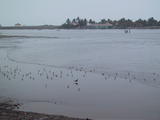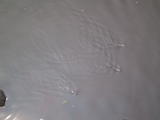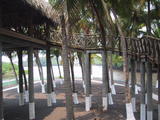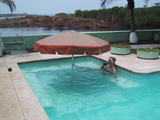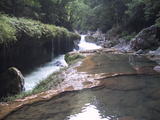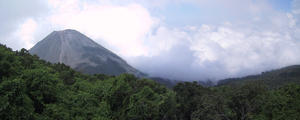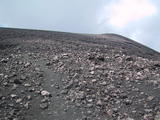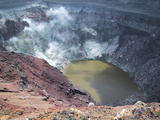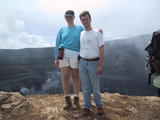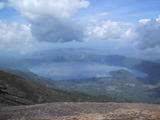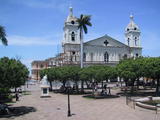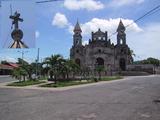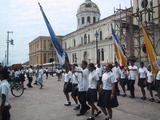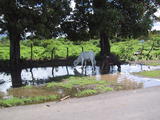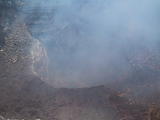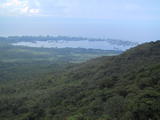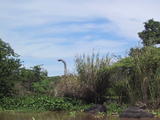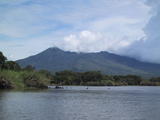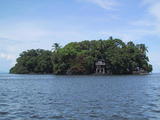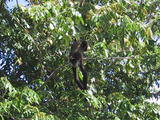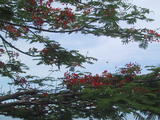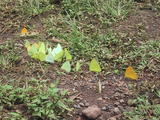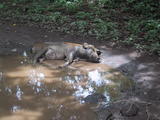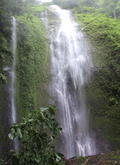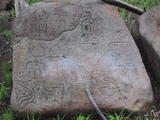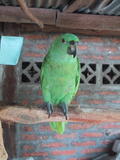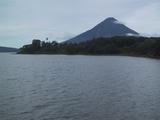| < < < Previous story | Next story > > > | |
Semuc Champey, El Salvador, Granada and OmetepeSan Jose, Costa Rica, 30 June 2003
Contents:Goodbye AntiguaDuring our last month in Antigua, we continued our Spanish lessons, and both had part time jobs. Maris was teaching English at a local school, to 5 and 6 year olds. It was her first experience as a teacher since her graduation. I did some software development, spending hours every day in the same Internet Cafe, connecting to a computer in the Netherlands developing software to integrate on-line credit card payments for an Internet shop in Holland. Leaving Antigua was not easy, the town after all had become our home. We also had our social life in Antigua after 4 months, even though many friends had already left before us. At the house we had gotten very involved in raising Willow, a beautiful kitten, that looks like a tiger. Giving her a lot of attention and even letting her sleep on our bed at night. Early in the morning she would meow to be let out of the room. She became a very social cat, enjoying the presence of people and came to greet us when we returned to house. At the table she would come and lie on my lap. Our land lady, Claudia, made a delicious dinner for our departure, and we partied into the early morning hours. The next morning was very difficult and tearful. It was hard to say goodbye to Claudia, with whom we have had a great time partying. One thing I will not forget quickly is the look on Willow's face as we said goodbye, as if she knew that something was wrong. Claudia promised to take very good care of her. Semuc ChampeyGetting to Semuc Champey is quite a trip, a 4 hour bus ride from the capital to Coban. Where we had to spend one night in Casa d'Acuña. We left our backpacks in this hotel (for 5 Quetzals per bag per day), and found our way to Lanquin with a microbus, even though it is only 50 km away the ride takes more than 2 hours over curvy dirt roads. In Lanquin we got on the back of a pick up truck that brought us to Las Marias, a hostel in the middle of Nature and close to Semuc Champey itself (a 10 min. walk, 1 km). We visited Semuc Champey the same afternoon, a beautiful and unique place, as a river goes rushing through a cave underneath you, while you are swimming in water pools above the cave. A truck load (literally) of schoolgirls had also found their way to Semuc Champey, and we were kindly offered a ride on the back of this converted cattle truck for the one kilometer ride to Las Marias. The girls had to continue for another 2.5 hours back to Coban. We returned to Guatemala City the next day, from where we went to El Salvador, on the most comfortable bus we have taken in Central America so far, the TICA bus. El SalvadorIn El Salvador the US dollar has replaced the Colon as the official currency, but prices are still listed in Colons in many places. Accommodation seems expensive, the Hotel we stayed at in Santa Ana was not really worth the 18 dollars we had to fork out. But transportation is cheap, the hour and a half ride from Santa Ana to San Salvador in the "special" bus costs 1 USD per person. Even though the country uses US Dollars, the Dollar bills are nearly as dirty as the Quetzal bills in Guatemala, since money is often carried in a bra and in armpits. It seems that in central America all currencies are linked to the US dollar anyway, steadily losing value against it, which in turn creates inflation. Replacing the national currency with the US dollar, prevents the government from printing money or from using the central bank's reserves to cover budget deficits (the latter is apparently what happened in Argentina). The Dollar itself however has been losing value against the Euro. When we arrived in Central America in January, 1 Euro bought us about 1 dollar, but now, we are getting 1 dollar and 17 cents, for us therefore, things have become about 15% cheaper since January. On the 10th of June, our first day in El Salvador, we climbed up El Salvador's highest volcano (2365 m). A difficult 4 hour climb to the top and back, really exhausted us. From Santa Ana we took bus number 248 that drives all the way to the park entrance. The bus ticket costs 76 US cents, the park entrance fee is 1 USD the guided and guarded tour costs another 1 USD, and there was another fee to pay, for god knows what, of about 60 cents. The guided and guarded tour is a good idea, since there are stories going around of people who climbed up and came back down with nothing but their underwear (a fate we would rather avoid). At 1 dollar for the guide and guard that's not a risk worth taking. There were only 7 foreign visitors to the park on the day we were there, and there is only 1 tour per day. Once on top, there is a beautiful view of the enormous crater and a lake. Sulfur fumes rise from cracks in the rocks. To the north of the volcano is a beautiful view of lake Coatepeque, a crater of a former volcano. People in El Salvador are really friendly, they hardly see any tourists since the country does not have well known tourist attractions. People smile at you just when they see you walk in the street or engage in a friendly chat and smiling boys come up to you and say "hello gringo". When you wave your hand for a ride you barely need to wait 10 seconds before someone will stop and even drive you to the place you want to go. We left San Salvador on the 05:00 TICA bus to Managua. GranadaThe taxi driver that drove us from the TICA bus station to the Granada microbus station, apparently didn't like the fact that I haggled down the price from 50 to 40 Cordobas for the 2km ride, that should have cost about 25. But after a 12 hour bus ride, you don't really have the energy to argue too long about what is after all only a dollar difference. His dislike of us for only being able to rip us of for 15 Cordobas instead of the intended 25 was quite obvious when he, mistaking us for Americans, put on an anti-American local radio program and further vented his anger by trying to run over a barking dog that was following the taxi. The taxi ride with this loser was short and fortunately the next Nicaraguan we met, our neighbor on the bus to Granada, was very friendly and pointed out all the sites along the way, such as the stockpiles of smoke coming out of volcano crater Santiago near Masaya. Once in Granada he walked us to our hostel. Granada is said to be the "Antigua of Nicaragua", but it is a small version of it, and our initial impression was therefore a bit disappointing. Fortunately we quickly met some people in our Hostel like Fara and Marc, who were working in a local bar called La Fabrica. A nice place to meet other travelers. The Danish owner of the bar takes care of the neighborhood street dogs. Volcano Mombacho, near Granada, rises into the clouds and is host to a so-called cloud forest. Unfortunately when we arrived at the entrance it was kind of closed, since there was no transportation up the volcano. We were incredibly lucky when Hugo and his son Hugo (a doctor in Miami, spending a couple of weeks in Nicaragua visiting his family), came along in their 4-wheel drive and offered to take us up with them. We would not have been able to see the cloud forest that day without them. Since the end of May, it has been raining nearly every day, usually for short and heavy showers, inundating streets. After another visit to an active volcano crater, Santiago, near Masaya we left Granada by boat for the Island Ometepe, crossing lake Nicaragua, that contains a unique species, namely fresh water sharks. However we did not see any. OmetepeWe stayed in Hacienda Mérida in the Mérida village on the southern part of Ometepe (the Maderas section). This was one of the cheapest places we stayed at, with bunks at 2.75 USD p.p, good and cheap food, bike and canoe rental. Together we spent approx. 20 USD per day and had a great time. Unlike Altagracia (where the ferry arrives from Granada), Mérida actually has water coming out of the tap. What's more, the water came straight from a source on the volcano and was fresh and drinkable. While cycling to the biological station to see the waterfall and the petroglyphs, we came across many aggregations of butterflies and "highways" of leafcutter ants crossing the street. A truly amazing sight! Much larger soldier ants came to check the threat our presence posed to the colony. We later learned that the leafcutter ants actually do not eat the leafs, but chew them into pulp to feed a fungus (this particular fungus is unique to the leafcutter ant colonies). Besides the soldiers and the workers another cast of leafcutter ants, the minima, harvest the fungus and feed the queen and the colony. All the ants in the colony are female. About 40,000 kings are produced once a year together with 10,000 new queens, these leave the colony and mate outside in the air. A queen will collect 300 million sperm from several kings, which she will keep to use during her entire life time (which can last up to 20 years). The males die upon performing their duty. Less than one percent of queens manage to start a new successful colony. When the queen dies the colony disintegrates. What's more these ants have a burial chamber, they collect their dead, even from outside, and dump them in this chamber. The last little detail is that approx. 15% of all leafs are harvested by leafcutter ants. All in all these ants have a very sophisticated farming society where every individual performs her duties selflessly and each is dependent upon the others for survival. I wonder if anybody would notice if you were a lazy ant... Cycling further along the unpaved roads of Ometepe, we encountered pigs cooling of in potholes and nearly all small children greeted us with a friendly "Hola!". The petroglyphs on this side of the island were difficult to find. After asking some people, they showed us some in their backyards and fields. Back at the hacienda, we learned about less fortunate times. In 1979 the Sandinistas expropriated all the land and houses belonging to their political opponents and from people who just happened to own something that a Sandinista wanted to have. After a decade without free elections the Sandinistas were tricked into organizing a free election, being under the illusion that they would win. When they did not, they used the last 3 months of power, before having to hand it over to the newly elected government, to appropriate as much as they could. This period is now referred to as "la piñata" (which normally refers to a birthday doll filled with candy, which upon breaking everybody rushes to collect). In 2003 many people are still trying to get their properties returned but the Sandinistas still hold many positions of power. This problem reminded me of the post-communist countries in Europe that also had to return properties to their rightful owners after the fall of communism. The next travel update will be about Costa Rica and Panama. If you want to be notified when we write more about our trip, just send us an E-mail. e-mail Otto de Voogd PhotosIztapaSemuc ChampeySanta Ana VolcanoGranadaOmetepePractical Information
To my knowledge the information provided here was accurate
at the time of our visit. However time passes and things can change.
TransportationTICA bus - Long distance busses in Central America. InformationPassplanet.com is a good website with guides to cities and accommodation in Central America. Money(ATMs for Maestro/Cirrus bankcards) El Salvador & Nicaragua: See Credomatic's ATM list (the only bank that has accepted our bankcards in Central America). Only US Dollars can be exchanged, Euros are not accepted. CostsGuatemala - Quetzal, approx. rates: 1 USD = 8 GTQ, 1 EUR = 9.23 GTQ Bus: Guatemala City -> Santa Ana (El Salvador): 72 GTQ per person. Very comfortable bus from the TICA bus company. El Salvador - US Dollar, approx. rate: 1 EUR = 1.17 USD
Santa Ana: Hotel Livingston: a double room with private bathroom is somewhat
overpriced at 18 USD.
Nicaragua - Cordoba, approx. rates 1 USD = 14.9 NIO, 1 EUR = 17 NIO
Granada: hospedaje Cocibolca, Calle La Calzada, 3 blocks from Parque Colon
towards the lake, a clean double room with private bath: 10 USD per night,
there are cooking facilities for guests. One of the best bargains in Granada.
| ||
| < < < Previous story | Next story > > > | |
New | About | Contact | Connect | Friends | Promotions | Copyright | Advertise
